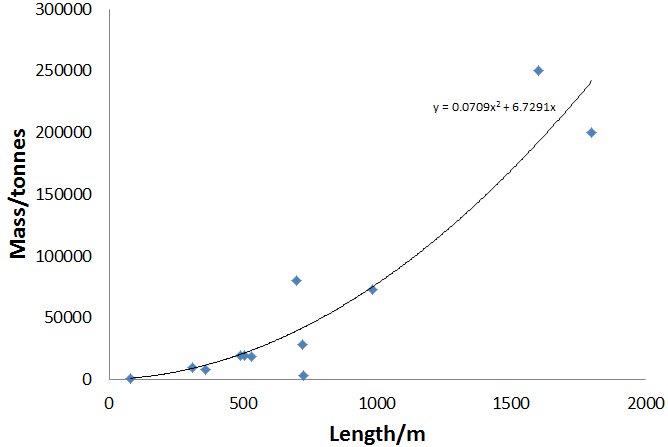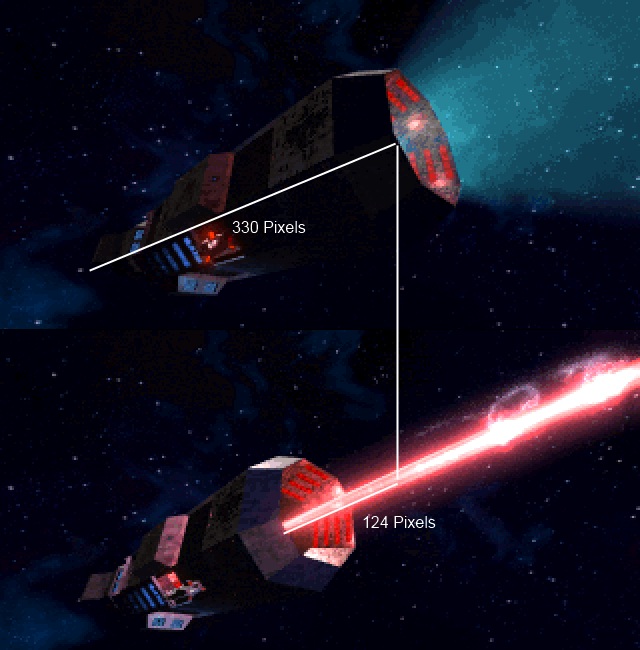Part 111: Loki System, Vega Sector, Mission 2 In which Ilanin does dubious physics
I said in the previous post I'd do some physics about the Behemoth's recoil after firing, so now seems a good time.The first step is to try and work out how heavy the Behemoth is. We don't have any official stats for the Behemoth, but when my Hellcat was in approximately the same place as the ship's engines the range to the Behemoth read just over 10000. The targeting box is in the middle, so let's assume the ship is 20000 long. The best explanation for what units it uses is that it's metres in the targeting computer and kilometres in the navigation one, so the Behemoth is 20 km long. Now, as it happens, the relationship between length and mass of known Confederation warships more-or-less follows a quadratic law (the R^2 is 0.89, so it's not brilliant but nor is it awful):

Plugging these numbers in to a length of 20 km gets a mass of about 28.5 million tonnes, which is about the same mass as the near-Earth asteroid 99942_Apophis, and somewhat less than the Three Gorges Dam in China, the heaviest ever man-made object. It is quite a lot of an extrapolation, though, since the longest Terran capital ship we know the mass of is the 2 km long TCS Midway, but probably order-of-magnitude correct (and as you'll see, that's plenty good enough to support my conclusions).
Now, for the strength of the recoil. Examining the cutscene suggests that the Behemoth is thrown back about a third of its length:

However, the force is a bit more than just that needed to push it back that far, since in the 3 seconds before it opens fire, the Behemoth travels about 93 pixels, or 5 km, towards the camera, and then opens fire and is thrown 124 pixels or 7.5 km away from the camera in 3.11 seconds. Now what actually happens is that it immediately lurches backwards and then seems to use its engines to kill the recoil while still firing, but I'm going to assume a smooth acceleration because it saves me having to do even more fiddling with frame-by-frame measurements.
Velocity before firing = +1667 m/s (positive is towards Loki VI)
Velocity 7.27s after firing = -2408 m/s
Change in momentum = 1.16*10^14 kgm/s
Since momentum has to be conserved in any event, this value is equal to the impulse supplied by the Behemoth's superlaser. The de Broglie equation gives the momentum of a photon as being equal to Planck's constant over its wavelength. We don't know the wavelength that the Behemoth is operating on, but that red colour is about 650 nm (yes, I know that you shouldn't be able to see light from a laser at all unless space near Loki VI is very dusty or something, so that colour may not be anything to do with the laser at all, but I don't have any better ideas for estimating a wavelength). That gives a momentum of 1.02 x 10^-27 kgm/s per photon, so it means that in the 3 seconds or so the Behemoth was firing, it must have thrown 1.14 x 10^41 photons at Loki VI. Given that the energy of a photon is equal to Planck's constant times the speed of light over the wavelength (3.06 x 10^-19 J here), that equates to 3.48 x 10^22 Joules of energy, or 1.16 x 10^22 Watts of power. Which is a) rather more than the Behemoth's supposed output of 5 x 10^17 Watts, but b) still about ten orders of magnitude too low to actually destroy a planet.
Of course, the fact that the thing recoils like a pistol rather than like something putting out a continous force in one direction could have told you that none of the artists or animators bothered to think about the physics involved without needing to go through all of the above, but where's the fun in that?
Actual story update hopefully later today. Only you can prevent me from Tripleposting!